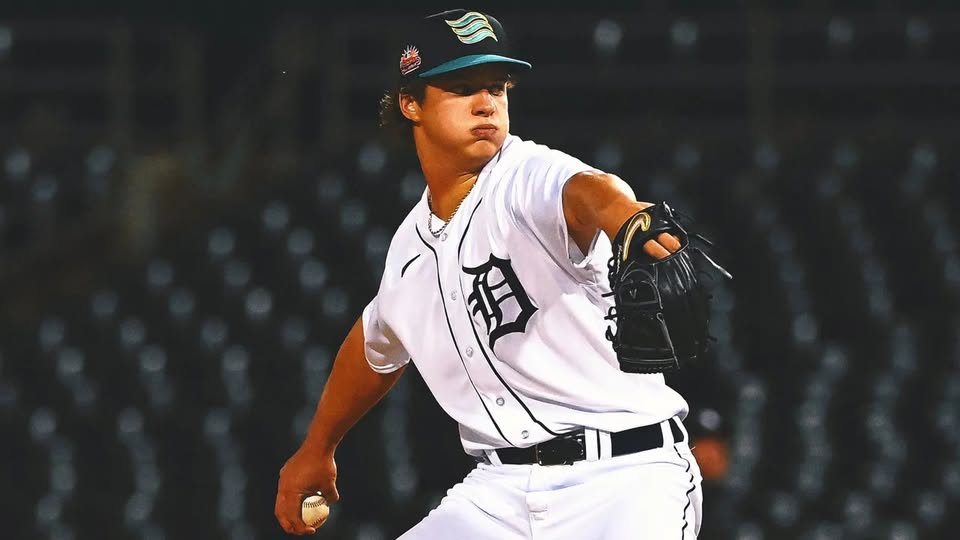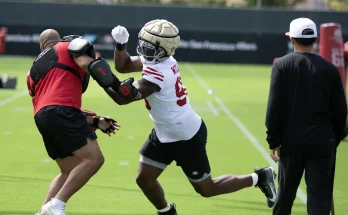The roar that echoed through Comerica Park on a cool April afternoon wasn’t just for a win. It was for the arrival of something new. Something hopeful. Something blue-chip. Tigers fans have waited years for a homegrown ace to emerge from the shadows of a rebuild. And while Jackson Jobe’s MLB debut wasn’t flawless, it signaled a turning point in the franchise’s journey.
Jobe, the No. 3 overall pick in the 2021 MLB Draft, finally made his long-anticipated first big-league start against the Kansas City Royals. Expectations were high, and so was the adrenaline. And though the box score may reflect a few bumps along the road, the 21-year-old right-hander showed flashes of brilliance, poise beyond his years, and, most importantly, promise.
A Debut Three Years in the Making
Since the Tigers selected Jobe out of Heritage Hall High School in Oklahoma City, the right-hander’s journey to the majors has been closely scrutinized. Possessing one of the most electric sliders in recent memory for a prep pitcher, Jobe entered professional baseball with immense expectations. But as with many high-school pitchers, development required patience.
Detroit has taken a deliberate approach with Jobe, carefully managing his innings and workload, especially after a back injury delayed his progress in 2023. He returned with a vengeance late last season, rising quickly through Double-A Erie and impressing in the Arizona Fall League.
With a strong spring showing in 2025 and a few dominant starts in Triple-A Toledo to open the season, the Tigers front office decided the time had come. It wasn’t just about filling a rotation spot—it was about signaling that the Tigers’ youth movement was officially underway.
The Start: Five Innings of Learning and Growth
Jobe’s final line against the Royals read: 5.0 IP, 4 H, 3 ER, 2 BB, 6 K. Not dominant, but certainly not discouraging. His fastball touched 97 mph. His slider drew swings and misses. His curveball showed depth, and his changeup—still a work in progress—flashed some potential. But what stood out the most was his demeanor.
In the first inning, Jobe found himself in early trouble. A leadoff walk followed by a bloop single had runners at the corners with no outs. But instead of unraveling, Jobe bore down. He induced a ground ball double play, allowing a run to score, and then froze Vinnie Pasquantino with a curveball to end the frame.
That composure spoke volumes.
“I was nervous, no doubt,” Jobe admitted in the postgame press conference. “But after that first pitch, I settled in. I trusted my stuff. I’ve dreamed about this moment since I was a kid, and now it’s here.”
In the third inning, he left a slider a little too up in the zone, and Royals outfielder MJ Melendez didn’t miss it—sending it 421 feet into the right field bleachers. Another run scored on a seeing-eye single in the fifth. But again, Jobe never lost his cool.
“He’s got that bulldog mentality,” said Tigers manager A.J. Hinch. “Even when things weren’t going his way, he stayed aggressive. He attacked hitters. That’s what you want to see from a young guy making his debut.”
Stuff That Plays
While Jobe’s command occasionally wavered, his arsenal was as advertised. The fastball sat comfortably at 95–96 mph with good life. The slider, which evaluators have called a “plus-plus” pitch since high school, generated five of his six strikeouts.
“I don’t want to get ahead of myself,” said Tigers catcher Jake Rogers, who was behind the plate for Jobe’s debut, “but that slider is as nasty as any I’ve caught. It’s a wipeout pitch. When he’s locating it, hitters don’t have much of a chance.”
According to Statcast data, Jobe’s slider averaged 2900 RPM—an elite spin rate. Several Royals batters swung over the top of it or froze when it broke late and sharp across the plate. He mixed in a handful of curveballs and a few changeups as well, keeping hitters honest.
“He’s got the weapons,” said Royals manager Matt Quatraro. “He’s still figuring it out, but once he does, he’s going to be tough to face.”
Room for Improvement
Of course, it wasn’t all sunshine and roses. Jobe’s pitch efficiency needs work—he threw 89 pitches in five innings, largely due to some deep counts and two walks. At times, he seemed to nibble instead of challenging hitters with his best stuff.
His changeup, while improving, still lacks the consistency needed to be a true fourth pitch at the major league level. But considering this was his first outing in The Show, the mistakes were forgivable and the positives far outweighed the negatives.
“He’s going to learn from this,” said Hinch. “That’s the biggest thing. This was his first taste. He got out there, got through five innings, and gave us a chance to win.”
Indeed, the Tigers rallied late to tie the game in the eighth before eventually falling 5–3 in extra innings. But Jobe’s debut remained the top storyline.
The Next Generation of Tigers Pitching
For years, Tigers fans have pinned their hopes on the emergence of a dominant, homegrown pitching staff. The names have come and gone—Casey Mize, Tarik Skubal, Matt Manning—each with moments of promise, each battling their own setbacks. Jobe represents the next wave.
And it’s not just Jobe. Wilmer Flores, Ty Madden, and Jackson’s younger brother, JJ Jobe, are all promising arms in the Tigers’ system. But Jackson stands out. Not just because of his draft pedigree, but because of the polish and maturity he’s shown at such a young age.
“This kid’s going to be special,” said Tigers pitching coach Chris Fetter. “He already understands sequencing. He studies hitters. He’s got the work ethic, the makeup, the competitiveness. He wants to be great.”
Jobe has been studying some of the game’s elite arms—particularly Jacob deGrom and Gerrit Cole—for both mechanics and mentality. “I love how calm deGrom is on the mound,” Jobe said. “He doesn’t show emotion, just gets the job done. That’s what I’m trying to emulate.”
The Bigger Picture: Tigers’ Rebuild Nearing Completion?
Jobe’s arrival feels like more than just the debut of a top prospect. It feels symbolic—perhaps even transitional. After years of languishing near the bottom of the AL Central, the Tigers are starting to see the fruits of their rebuild bloom.
Riley Greene and Spencer Torkelson are maturing. Colt Keith has impressed at second base. Kerry Carpenter continues to swing a hot bat. And now Jobe has joined the party.
The Tigers aren’t World Series contenders just yet, but they’re no longer the cellar dwellers of years past. With a blend of youth, veteran leadership, and a steadily improving farm system, Detroit may be a team to watch in the second half of 2025 and beyond.
“You can feel it in the clubhouse,” said Rogers. “There’s a belief now. The young guys are hungry. The vets are locked in. We’re building something.”
What Comes Next for Jobe?
Barring any setbacks, Jobe will remain in the Tigers’ rotation moving forward. Hinch and Fetter have said they’ll monitor his innings and workload closely, but he’s here to stay. And while he’ll likely have ups and downs—like any young pitcher—his ceiling is undeniable.
Scouts believe Jobe has ace potential. That’s not hyperbole. With his combination of velocity, movement, command, and makeup, he could eventually slot in as a No. 1 or No. 2 starter on a playoff-caliber team.
He’ll face stiffer lineups. He’ll pitch in hostile environments. He’ll learn the nuances of game-planning, adjusting, and battling fatigue. But he’s already taken the most important step: proving he belongs.
“I’m going to keep learning,” Jobe said after the game. “I know I’ve got a lot of work to do, but I’m excited for the challenge. This is just the beginning.”
Final Thoughts: A Glimpse Into the Future
Jackson Jobe’s first MLB start may not make the highlight reels or stat columns of history. It didn’t involve a shutout, a no-hitter, or double-digit strikeouts. But for Tigers fans, it was something even better: a glimpse of what’s to come.
The last time Detroit saw a homegrown ace emerge, it was Justin Verlander back in 2005. Now, two decades later, Jobe steps into the spotlight as the franchise’s next great hope. And if his debut is any indication, the Tigers may finally be ready to turn the corner.



